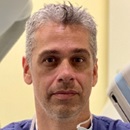
Interventional Radiology Department
Diagnostic Department
Call center
210 618 4000 Interventional Radiologists are specialized radiologists who use minimally invasive techniques. They have extensive training and provide advice and treatments across all medical specialties. Interventional procedures are either X-ray-guided (Fluoroscopy), using state-of-the-art equipment (Digital Angiography System), or ultrasound-guided or CT-guided by next-generation scanners (Multislice CT).
Nowadays, many conditions that previously required open surgery can be treated without surgery by Interventional Radiologists. Interventional Radiology offers reduced risk, less pain, and shorter recovery time compared to open surgery.
At the Interventional Radiology Department of IASO General Clinic, the following procedures are performed:
- Diagnostic intra-arterial digital angiographies for all organs (brain, neck, spinal cord, chest, abdomen, viscera, upper and lower limbs).
- Diagnostic venographies.
- Percutaneous thermal ablation (RF ablation – MW ablation) of liver and kidney tumors.
- Embolization of benign and malignant tumors in the liver, kidneys, upper and lower limbs.
- Varicocele treatment via embolization.
- Preoperative embolization of the portal vein, spleen, or tumors in other viscera.
- Angioplasty and stent placement for stenoses or blockages in arteries of the upper and lower extremities or visceral arteries (e.g., renal arteries), as well as carotid arteries.
- Thrombolysis or thrombectomy of visceral and peripheral arteries and veins.
- Thrombolysis of pulmonary branches and mechanical thrombus aspiration of venous branches (e.g., superior vena cava, brachiocephalic veins, subclavian veins).
- Expansion and stent placement for venous stenoses (e.g., superior vena cava syndrome).
- Abdominal aortic aneurysm repair via endovascular stent-graft placement.
- Inferior vena cava filter placement to prevent pulmonary embolism.
- Embolization of arteriovenous malformations and fistulas (excluding CNS) and tumors in any part of the torso- limbs and viscera (benign-malignant tumors, pulmonary hemorrhage, digestive system, female reproductive organs, liver).
- Placement and management of central venous catheters for hemodialysis or chemotherapy (PICC – Port)
- Placement and management of specialized chemotherapy ports.
- Percutaneous nephrostomy and ureteral stent (pigtail) placement.
- Percutaneous transhepatic cholangiography and biliary drainage, with or without stent placement.
- Transjugular liver biopsy.
- Transjugular intrahepatic portosystemic shunt (TIPS)
- Percutaneous drainage of thoracic or abdominal collections under ultrasound or CT guidance, in the corresponding sections.
- Percutaneous biopsies under ultrasound or CT guidance, in the corresponding sections.
- Percutaneous gastrostomy and gastrojejunostomy for patients unable to take nourishment orally.
- Percutaneous stent placement in obstructions or stenoses of the esophagus and duodenum.
- Hepatic radioembolization with Yttrium-90
- Hepatic chemoembolization.
- Management of chronic musculoskeletal pain
- Discoplasty with laser or Discogel.
- Percutaneous vertebroplasty and kyphoplasty.
Staff











